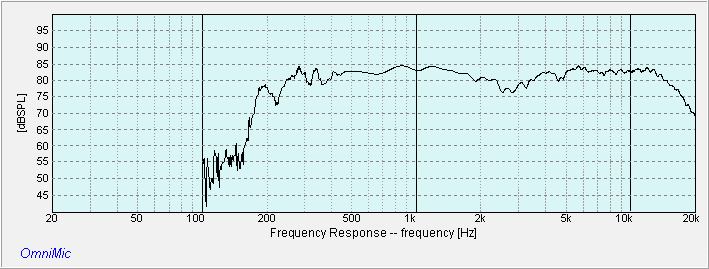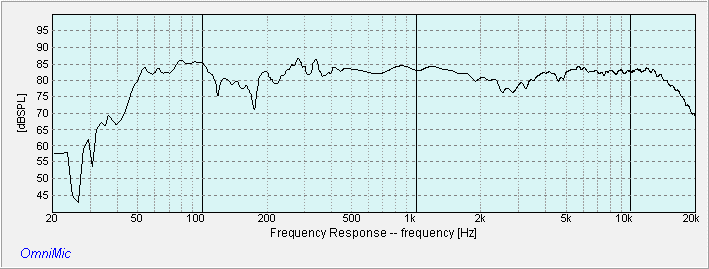|
Swallow-M for Music
After listening to the Swallow, I found that it works best as a satellite with it placed high up on a wall. When it’s placed on the floor, as like in a 3way box, the “glare” in the midrange is noticeable. That comes from the bump from 2kHz~5kHz. It’s an unfortunate by-product of simplifying the Swallow-TPC crossover.
In this design, I did away with trying to achieve a flat response. Instead, I decided to voice the Swallow for music. This meant re-working the Swallow crossover for a more pleasing music reproduction. Since I’m at it, I upgraded the budget Thruster THW835 to an 8″ Peerless 830869 Nomex woofer.
 Fig 1 – Peerless GBS-85N25PR03-04 with BC25SC08-04 Fig 1 – Peerless GBS-85N25PR03-04 with BC25SC08-04
Fig 1 are the revised plots of the GBS85N and the BC25SC08 with their new networks. As can be seen, I am still working with a minimal component objective in the crossover.
 Fig 2 – Swallow-M Frequency Response Fig 2 – Swallow-M Frequency Response
Fig 2 is the Summed Response of the GBS85N with the BC25SC08-04. Note the dip centered at 3kHz. That eliminated the over the top presence in the midrange.
 Fig 3 – Swallow-M with Peerless 830869 Fig 3 – Swallow-M with Peerless 830869
Fig 3 is with the Peerless 830869 integrated in with an electronic crossover at 200Hz (24dB/oct). Disregard the dip at 150Hz. It’s caused by a floor bounce in my measuring setup.
 Fig 4 – Swallow-M Waterfall Fig 4 – Swallow-M Waterfall
Fig 4 is the Waterfall of the Swallow-M. There are some artifacts seen at 2.5kHz and 5kHz but they are not harmful. My guess is they originate from the GBS85N’s cone breakup.
 Fig 5 – Swallow-M Spectrogram Fig 5 – Swallow-M Spectrogram
The Spectrogram in Fig 5 shows a 3.5kHz spot at 4msec. Fortunately, it disappeared by 5msec.
 Fig 6 – Swallow-M Toneburst Energy Storage Fig 6 – Swallow-M Toneburst Energy Storage
Fig 6 shows the unwanted excess energy (light blue slices). There is a bunch of excess energy at 2kHz~3kHz and another from 4kHz~6kHz. They will not affect the music as they do not last more than 6 cycles.
 Fig 7 – Swallow Harmonic Distortion Fig 7 – Swallow Harmonic Distortion
The Harmonic Distortion of the Swallow-M is in Fig 7. The THD (H2-H9) is slightly higher at 0.746%. 2nd Harmonic is at 0.365% whereas the 3rd Harmonic is 0.360%.
 Fig 8 – Swallow-M Step Response Fig 8 – Swallow-M Step Response
Fig 8 is the Step Response of the Swallow-M. We can clearly see the time displacement between the GBS85N and the BC25SC08.
Sound of Swallow-M with the Peerless 830869
The Swallow-M is definitely more musical than the Swallow. Gone is the irritating “glare” in the midrange. This dip at 3kHz in the response is sometimes known as the BBC dip. Regardless of what it’s called, our ears are very sensitive around 3kHz. Any emphasis in that region will be magnified. By reducing the amplitude, the vocals recede slightly back into the sound-stage. Otherwise, it will be too forward.
The Peerless 830869 elevated the system to a whole new level. The bass of the 830869 is so much more articulate compared to the Thruster THW835.
Actually this is the first time I’m really enjoying the 830869. Over the years, I tried designing 2-ways with it but was never satisfied with the outcome. While they measured well, the speakers don’t involve me. However, when the 830869 is used strictly for bass in a 3-way, she shines.
In Summary
This is a speaker I’m happy to recommend. I had to abandon the lowest cost objective by replacing the Thruster THW835 with the Peerless 830869 but the additional cost is well worth it. This is one design I can live with.
Unless otherwise stated, all measurements were made in Full Space (4 pi) with the mic at 36 ins, tweeter axis. Impulse Window=5ms. No smoothing applied. |

